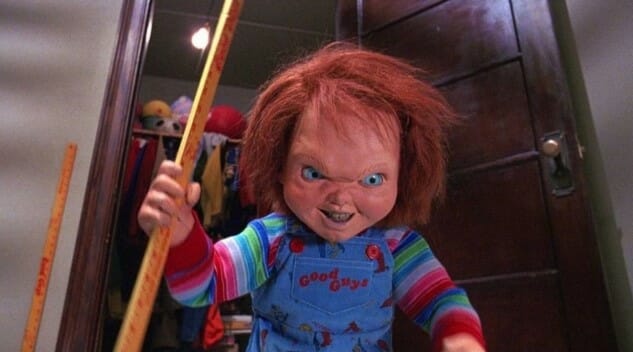
The idea of a “killer doll” wasn’t exactly an unexplored thought when Child’s Play arrived in 1988. Surely, there were some fans in the audience who immediately thought back to the likes of “Talky Tina” on The Twilight Zone …or any of the several other episodes of that series that also dealt with dolls or dummies come to life. Although the concept had been broached before, none of those other dolls had a personality half as large as that of Charles Lee Ray. That’s “Chucky” to his friends.
Child’s Play was a series that fascinated people. Even viewers with no knowledge of the slasher genre—running out of gas and short on ideas by 1988, if we’re being honest—were drawn to the concept of a foul-mouthed little doll empowered by voodoo magic, blood lust and Brad Dourif’s manic voice. I can vividly remember grade school lunch conversations about the series in the early ’90s, held between groups of children collectively lying to each other about having seen “those Chucky movies.” Even though we didn’t know what we were talking about, Child’s Play stood out as some kind of cinematic forbidden fruit. The VHS covers are burned into my memory, after seeing them during every Blockbuster Video excursion.
Nor has the series gone through what you might call a typical franchise trajectory. After burning out in theatrical releases in the 2000s, one would naturally have expected Child’s Play to be more or less gone from the cultural discourse by this point. And yet the films actually managed to improve during their straight-to-video and VOD era, leading to renewed interest and the release of a modern remake, this one starring the voice of none other than Mark Hamill. At the same time, there’s also the surprisingly well-received new Syfy TV series, simply titled Chucky.
Now is the time, then, to reexamine the entire Child’s Play series, and put every Chucky outing in its place—including the remake. Here they are, from worst to best.
8. Seed of Chucky (2004)Director: Don Mancini
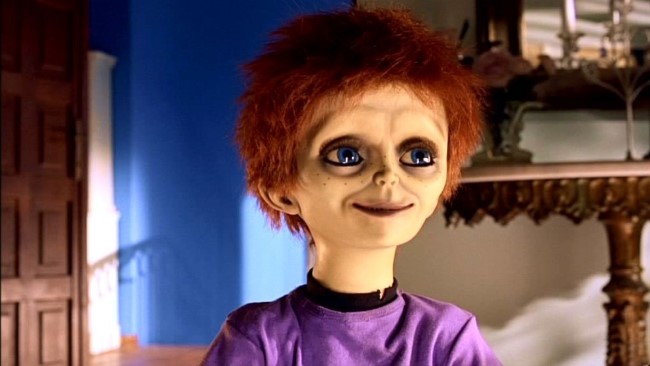
Of all the entries in the Child’s Play series, Seed of Chucky had perhaps the shakiest foundation from the start. It’s burdened by its direct connection to the similarly weak Bride of Chucky, and completes that film’s abandonment of any attempt at making a legitimate horror film. Also: I can barely bring myself to look at the face of Chucky’s progeny, Glen—I don’t know what it is about that doll, but it’s so aesthetically unpleasant that it triggers genuine revulsion, and not in a genre-appropriate way. This thing is plain ugly, and I hate it with a not entirely rational bitterness.
Seed of Chucky plays out almost like two films, both of which are different flavors of comedy. One is an occasionally amusing, meta-winking Hollywood farce that sees Jennifer Tilly playing “herself,” attempting to land a part playing the Virgin Mary through use of sex. The other sees Chucky and his doll wife Tiffany (also voiced by Tilly) brought back from the dead only to bicker about how to raise their emotionally and sexually confused offspring. The film’s got some fun, insider Hollywood gags, including a number of references to the filmographies of Ed Wood and John Waters, but Seed of Chucky falls flat on its face at any point when it has to revisit any kind of “horror” bonafides. It feels tired, lazy and endlessly self-referential, like a confession that Mancini had no interesting avenues left to explore with the character. It’s telling that this is the least charismatic of all the performances by Brad Dourif as Chucky—it just seems like his heart isn’t in it at this point, and his presence is curiously absent from the film, despite it bearing his name. A subplot about Chucky not being allowed to kill anymore mirrors the way the character had been culturally defanged by the time this film premiered. The film effectively ended Child’s Play as a franchise with theatrical clout, until the new remake.
7. Bride of Chucky (1998)Director: Ronny Yu

If Child’s Play 3 is an example of the original film’s established formula beginning to run thin, then Bride of Chucky is something of an overreaction to the idea that the series should go in a new direction. It wasn’t a bad thought, per se, to abandon the convention that Chucky was going to keep stalking the same kid (Andy Barclay) over and over in order to swap his soul into Andy’s body, but Bride of Chucky tries to reinvent itself a bit too slavishly in the mold of Scream, and believes itself to be significantly more clever than it is. This is the Child’s Play film that first prioritized mythology and character-building over slasher elements, to its detriment.
Jennifer Tilly makes her debut here as Tiffany, a former girlfriend of serial killer Charles Lee Ray, whose soul is of course contained within the Chucky doll. She’s responsible for his resurrection following the end of Child’s Play 3, and she chews her dialogue with a tacky abandon that is fairly enjoyable. The “criminal lovers on the run” storyline, on the other hand, is an awkward fit for the series, abandoning the tension and horror elements of earlier entries in favor of lovers’ quarrels and the requisite puppet sex scene you knew would be there. One wonders why they bother with allusions to Bride of Frankenstein at all, when the tone has more in common with Natural Born Killers. But hey, at least we got a Chucky appearance in World Championship Wrestling out of it—Brad Dourif voice and all.
6. Child’s Play 3 (1991)Director: Jack Bender
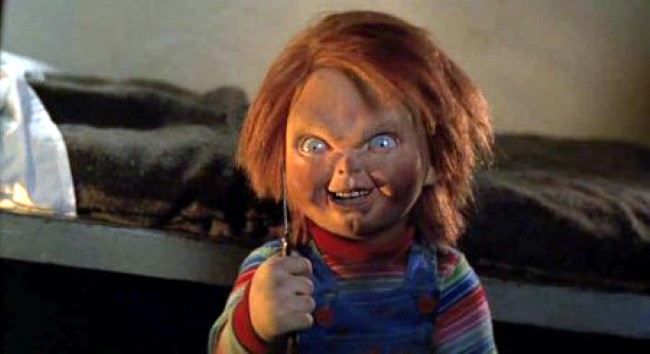
The early ’90s were a rough time for the slasher genre—and horror in general. A wave of rising, Gen X cynicism seemed to hurt the genre’s ability to fall back on its tropes, and the films of the time period often responded by pushing the boundaries of silliness or refreshing their settings, rather than making earnest attempts at being scary. There was a palpable sense of ennui in the air at the time, which didn’t really dissipate until the release of Scream in 1996. So it is with Child’s Play 3, which directly continues the story of the first two films, albeit with a little something missing. Of all the Child’s Play entries, this is the one that most feels like it could be tweaked into something significantly better than it is.
Andy Barclay (Justin Whalin) is again our protagonist, now a “troubled” 16-year-old sent to live at a military academy because he can’t leave his childhood “fantasies” of a killer doll behind him. But he’s significantly less likable as a flat-topped, milquetoast teenager than he was as a brave little boy. Chucky is of course revived, and makes a beeline for the school, where his nature is accidentally discovered not by Andy, but by a very young cadet named Tyler (Jeremy Sylvers), one of the dumber horror movie protagonists in history, unable to see that this living, very clearly evil doll poses him some kind of threat, even after being warned by Andy. We then devolve into the same body-swapping plot seen in the first two films, except with Tyler as the target and Andy as the sibling-like protector. Overall, Child’s Play 3 is simply less focused and more bluntly written than its predecessors, with weak supporting characters and a military school setting that isn’t well utilized. The ultimate highlight is its conclusion in a totally unrelated carnival haunted house, where Chucky admittedly dies one of his better deaths, being chopped to bits by a giant industrial fan in a geyser of blood and gore.
5. Child’s Play (2019)Director: Lars Klevberg

The Child’s Play remake is difficult to slot into this list, given that it never comes anywhere particularly close to feeling like an entry in the franchise. Suffice to say, this is not the Chucky you knew. Somewhere along the way, someone made the decision that having the soul of a human serial killer trapped in the body of a doll was a less narratively rich goldmine than “a robot doll that accidentally gets its morality switch flipped to evil.” We would suggest that this line of thinking proves to be incorrect, at best, and that not even Black Mirror would be able to get much out of it. This Chucky is less an individual character, and more a stand-in for Google, the Cloud and the NSA all at once. Like the doll, the film lacks a human soul.
It is indeed the reframing of Chucky’s violent streak that poses its biggest problem. The doll of the original Child’s Play is both frightening and funny because it contains the soul of a character who is so diametrically opposed to its cute, cherubic appearance: It’s inherently funny to see Dourif work through such a silly vessel and bring his own personality to the forefront. This new Chucky, on the other hand, almost automatically lacks depth despite Mark Hamill’s attempt at characterization, chiefly because he was written to be a digital ingenue led to evil—not instinctively, but accidentally. Are we supposed to pity Chucky, root for him or want him dead? It doesn’t help that he doesn’t fully settle into murder mode until the third act.
On the plus side, the film can boast solid performances from most of its leads, especially Brian Tyree Henry as the reimagined detective Mike Norris, and perhaps most importantly, it delivers on the blood and gore with sanguine aplomb. The film’s effects are otherwise on the shaky side—there are some random moments of CGI involving the doll that will leave you amazed at their awfulness—only just clearing the bar of basic entertainment. A whole new generation may embrace its technophobic aspects as a fitting horror film for 2019, but Child’s Play fans will likely shrug and move on.
4. Curse of Chucky (2013)Director: Don Mancini
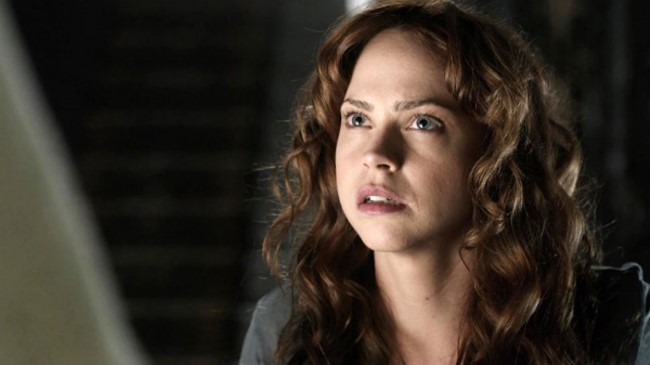
With Curse of Chucky in 2013 and Cult of Chucky in 2017, Don Mancini pulled off something truly rare: He brought a horror franchise back from the dead after its worst installments, and he did it within the framework of direct-to-video and VOD offerings. Because to be sure, after Seed of Chucky, you would have been forgiven for being extremely skeptical that Curse was going to be a return to form. Yet, somehow, it improbably is. A complete tonal reset, this film represents the series creator simultaneously going back to his roots and tying together the increasingly labyrinthine series mythology in a surprisingly satisfying way. It makes an earnest effort both toward being scary and setting the stage for a “next generation” of Child’s Play recurring characters. The only downside: It lacks the budget to really go quite as far as it wants to go, something that is slightly better realized by Cult of Chucky.
Still, Curse is a lean, mean throwback slasher. It takes place largely in a modest, single setting, establishing the new protagonist of Nica Pierce, a paraplegic woman with a tragic connection to serial killer Charles Lee Ray in her past. Nica is played by Brad Dourif’s daughter, Fiona Dourif, in a casting decision that could just have been a self-referential stunt, but instead turns out remarkably well—for the first time since Andy Barclay, Chucky has a true nemesis to work against. The film’s increased gore and mean-spirited violence, too, skews closer to the Chucky movies we remember from the first two Child’s Play installments. One knock: The FX on the Chucky dolls themselves is sadly constrained by budget, which results in some truly out-of-place moments of poor CGI (used to animate Chucky’s face in particular). It’s a shame that only slightly dulls what was a triumphant return to form for the series, and one that sets up for a far crazier sequel. Also: A+ post-credits Easter egg in this one.
3. Cult of Chucky (2017)Director: Don Mancini

Where Curse concerned itself with making Chucky seem threatening and appropriately edgy again, Cult does the same while embracing the extremes of insanity presented by the franchise’s mythology. Amusingly, in a series that has constantly revolved around preventing Chucky from completing a round of “hide the soul,” Cult not only examines what would happen if he finally succeeded, but revels in just how many ridiculous situations would no doubt arise if the little devil actually had his way. The results are appropriately ludicrous.
A particularly charismatic Fiona Dourif is back for her second round as Nica Pierce, this time confined to a mental institution for clinging to her supposed Chucky delusions, but it quickly becomes apparent that the spirit of the possessed Good Guy doll has followed her into exile. What unfolds is a bonkers collection of Grand Guignol sequences, featuring some inventively disturbing gore in a setting (white, antiseptic, futuristic and cold as hell) that works unexpectedly well as an exotic counterbalance to the more familiar locales of Curse. Finally, Cult functions equally well as both an ending or new beginning to the series as a whole, given the way it loops old characters such as Andy Barclay and Tiffany back into the fray, presenting them as capable but vulnerable to long-simmering comeuppances. One would not think that Mancini would be able to tie the franchise story together nearly as neatly as he does here.
2. Child’s Play 2 (1990)Director: John Lafia

Child’s Play 2 was released in theaters toward the tail end of an era when horror sequels (especially slashers) had become such an inevitability that they were almost uniformly regarded with derision by critics, if not by the horror geeks. As a result, contemporary assessments of the franchise’s first sequel have a tendency to harp on the fact that it exists at all, while ignoring much of its impeccable craftsmanship. Rest assured: Child’s Play 2 is pretty awesome—in some ways superior even to the first film. It sequelizes in the old style, taking the formula of the original outing and simply making everything bigger and more bombastic—especially the FX, which are truly impressive throughout. Chucky has never looked better than he does here, articulated to convey a harmlessly cherubic face one moment, and a snarling, swearing psychopathic visage the next.
The plot of Child’s Play 2 picks up where the first left off, although we sadly don’t get a return from Catherine Hicks as Karen Barclay. Instead, Andy (Alex Vincent) is now living with a foster family, where he bonds with his older adoptive sister Kyle (Christine Elise McCarthy). Chucky returns as well, reforged in a new doll body and replacing another Good Guy doll in the household that Andy doesn’t have explicit reason to fear.
Compared to the original film, the sequel is a bit less tense, a bit less atmospheric—it gets less mileage from the mystery element of who is committing these murders, but that’s to be expected. Instead, it leans heavily into Brad Dourif’s profane, slavering characterization of Chucky, which is a joy to behold. The way the doll howls in human pain as he’s repeatedly outsmarted through the 20-minute toy factory finale—the best sequence in franchise history—is a testament to how simultaneously disturbing and hilarious Dourif manages to make this odd little character.
1. Child’s Play (1988)Director: Tom Holland
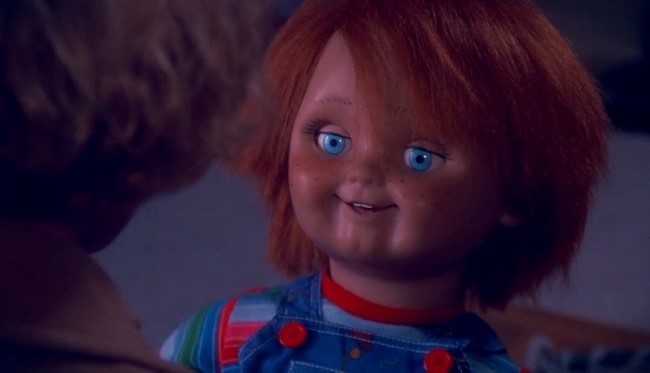
Child’s Play is one of those late ’80s gimmick slashers where it’s all too easy to feel as if you’ve already seen the film, without actually having sat down to watch it. Killer doll, very cheesy, plenty of one-liners, right? Well yes, and no. The original (and best) entry in the Child’s Play series is the most serious-minded (at least slightly) and grounded of the movies, and it goes out of its way to humanize its iconic killer Chucky—or the spirit within him, that of serial killer Charles Lee Ray—more than one might expect. If you’ve never seen a film in the series, ask yourself this: Did you know that the plot of Child’s Play is technically all about voodoo? Because it is. In the end, though, its greatness and inherent watchability boils down to the charms of the wonderful Brad Dourif, who found in Chucky the vessel he needed to become a genre legend forevermore. Like Robert Englund did with Freddy Krueger, Chucky becomes the most beloved aspect of the series because Dourif’s voiceover just oozes charisma and character. He’s more alive than any of the flesh-and-blood characters in this series could ever be, although Child’s Play does give him some more-than-adequate foils. It’s just one of those sublime moments of perfect casting—it’s easy to imagine that the series would never have extended into seven sequels if not for his presence.
In comparison with those sequels, the original entry in the series is notably more atmospheric and patient, with better supporting roles than any of the films that would follow—particularly Chris Sarandon as police detective Mike Norris, who realistically struggles with the mounting realization that the spirit of Ray is somehow killing from beyond the grave. The Chucky doll, meanwhile, looks more innocuous than in later installments, which amplifies the extent of its changes in facial expression. Coupled with the talents of Dourif, who gives Chucky a countenance that is both unsettling and inherently, morbidly funny, it made Child’s Play a cultural touchstone that is well known even to those who don’t regularly watch horror films.
Jim Vorel is a Paste staff writer and resident horror guru. You can follow him on Twitter for more film writing.